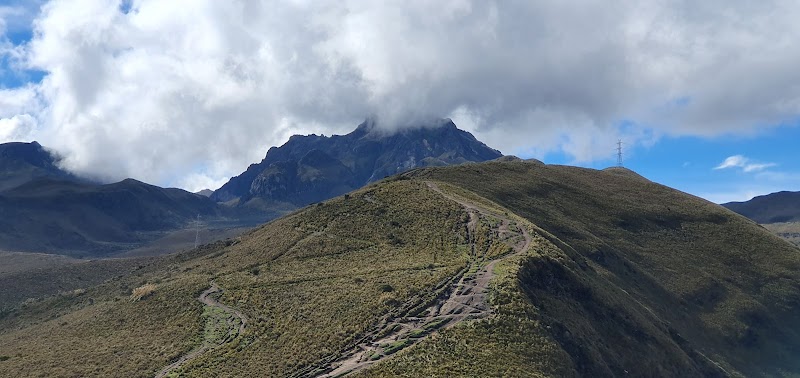
The Virgen de El Quinche Pilgrim Path: Quito’s Sacred Hike
The Virgen de El Quinche pilgrimage near Quito invites adventurers on a 14-kilometer ascent blending spiritual tradition with rugged terrain. With forested trails, sweeping vistas, and a historic shrine as your goal, this hike balances challenge and cultural depth for a unique outdoor experience.
Start Early to Avoid Heat
Begin your hike early morning to comfortably beat the midday sun and allow plenty of time for rest stops.
Carry Enough Water
With limited water sources on trail, bring a minimum of two liters to stay hydrated throughout the hike.
Wear Proper Footwear
Choose sturdy hiking shoes with good tread to manage loose dirt, rocks, and occasional mud patches effectively.
Prepare for Weather Changes
Bring layers and sun protection; mountain weather can switch quickly between chilly and intense sun exposure.
The Virgen de El Quinche Pilgrim Path: Quito’s Sacred Hike
The Virgen de El Quinche pilgrimage is more than a journey; it’s an encounter with a landscape that moves with ancient purpose. Starting from Quito, the path stretches roughly 14 kilometers one way, winding through Pichincha’s uneven terrain with an elevation gain close to 800 meters. The route tests endurance without overwhelming, a demanding dance with a forest that breathes, whispers, and challenges.
The path begins on dirt roads flanking farmlands before dipping into thick eucalyptus groves. The trees stand tall, their branches swaying as if guiding pilgrims forward, teasing the senses with rustling leaves and fresh pine scents. Streams cross the trail, their waters teasing and daring those on foot not just to continue, but to listen. The forest isn’t just background—it pushes and prods, fierce and quietly insistent.
Along the way, vistas unfurl like cinematic frames—the surrounding hills roll beneath striking skies, and Quito’s sprawl appears far below, veiled in early mist or afternoon glare. Staying hydrated is crucial; water stations are scarce, so pack at least two liters. Sturdy hiking shoes with solid grip navigate slick dirt, loose stones, and occasional mud patches effectively. A moderate fitness level suffices, though stamina and some uphill effort are constant companions.
Timings matter. Starting early prevents the midday heat and guarantees time to absorb quiet moments at checkpoints that offer respite and reflection. The pilgrimage concludes at the shrine of Virgen de El Quinche, a spiritual anchor since the 16th century. This destination isn’t a mere endpoint but a space filled with rituals and reverence, drawing visitors from all walks.
For first-timers, understanding the cultural significance adds layers to the walk—each step connects to generations of faithful seeking blessings and renewal. Season-wise, the dry season from June to September offers clearer trails and views, while green bursts after rains in other months ignite the landscape’s vibrancy but demand better footing.
Be prepared for weather swings: the mountain air can chill suddenly, making lightweight layers essential. Don't underestimate the sun’s power at high altitude; a hat and sunscreen deliver as much protection as your resolve. The pilgrimage balances physical challenge with spiritual momentum, a conversation with land fiercely itself, requiring respect and readiness.
In all, the Virgen de El Quinche pilgrimage is an adventure where sacred meets soil, and personal limits brush against nature’s grit. Whether walking as a pilgrim or an explorer, the trail offers an experience grounded in history, energized by wilderness, and deeply rewarding in its demanding simplicity.
Nearby Trips
All Adventures
Boat Charters
Water Activities
Adventures near Quito, Pichincha
Discover the unique and memorable adventures that make Quito, Pichincha special.
Frequently Asked Questions
What is the cultural significance of the Virgen de El Quinche pilgrimage?
The pilgrimage honors the Virgen de El Quinche, a revered figure since the 16th century, and draws thousands seeking blessings. The walk embodies both spiritual devotion and connection to Ecuadorian traditions, making each step part of a centuries-old ritual.
Are there any water stops along the way?
Water stations are infrequent on the route, so hikers should carry sufficient water to last the entire hike. Streams along the trail shouldn’t be relied upon for drinking due to potential contamination.
What kind of terrain can I expect on the hike?
Expect a mix of dirt roads, rocky stretches, and forested paths with occasional mud patches. The trail climbs steadily with some steep inclines, requiring good foot traction and steady pacing.
Is the pilgrimage suitable for children or casual hikers?
While moderate in difficulty, the hike can be tiring due to elevation gain. Families with children should assess fitness levels realistically, and casual hikers should prepare for a sustained uphill journey.
Are there lesser-known viewpoints along the route?
Yes, hidden clearings within the forest offer peaceful vantage points overlooking Quito and surrounding valleys. These spots provide quieter moments away from the main trail bustle.
What wildlife might I encounter?
Birds such as hummingbirds and tanagers frequent the forest canopy. Small mammals and occasional reptiles are part of the local ecosystem; observing quietly is encouraged to preserve the environment.
Recommended Gear
Sturdy Hiking Shoes
Good grip and ankle support are critical for navigating rocky and sometimes slippery terrain.
Hydration Pack or Water Bottles
Carry sufficient water to avoid dehydration, especially since sources are rare along the route.
Layered Clothing
Weather can shift between chill and sun quickly, so wear breathable layers you can add or remove.
Sun Protection
A hat, sunglasses, and sunscreen protect you from intense equatorial rays during the hike.
Local Insights
Hidden Gems
- "Forest clearings with panoramic views northeast of the pilgrimage path"
- "Small shrines and chapels tucked along secondary trail sections"
Wildlife
- "Andean hummingbird"
- "Tanager species"
- "Small forest mammals like agoutis"
History
"Dating back to Spanish colonial times, the Virgen de El Quinche shrine became a central pilgrimage site by the 16th century and remains a vital cultural destination representing faith and community."
